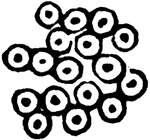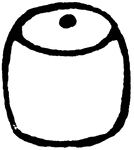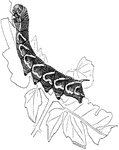
Caterpillar and Chrysalis of Pieris Brassicae
"It lives in groups on cabbages in gardens, and similar vegetables. It is so voracious that it consumes…
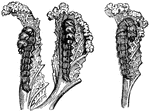
Caterpillars of the Cabbage-Butterfly
"Shows how the head advances over half the circumference of the circle which it has to describe, and…
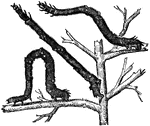
Caterpillar of the Canary-Shouldered Thorn
"Their attitudes deceive even the close observer; they embrace the stem of the leaf or twig with their…
Looper Caterpillar at Full Length
"Represents the Looper caterpillar, with four membranous legs. If one of these caterpillars, lying quiet…
!["Represents the Looper caterpillar, with four membranous legs. If one of these caterpillars, lying quiet at full length, determines to walk, in order to take its first step it begins by humping its back, curving into an arch that part which has no legs, and finishes by [lying flat]"](https://etc.usf.edu/clipart/52200/52221/52221_cater_arch_mth.gif)
Looper Caterpillar Curved into an Arch
"Represents the Looper caterpillar, with four membranous legs. If one of these caterpillars, lying quiet…
!["Represents the Looper caterpillar, with four membranous legs. If one of these caterpillars, lying quiet at full length, determines to walk, in order to take its first step it begins by humping its back, curving into an arch that part which has no legs, and finishes by [lying flat]"](https://etc.usf.edu/clipart/52200/52217/52217_looper_cater_mth.gif)
Looper Caterpillar
"Represents the Looper caterpillar, with four membranous legs. If one of these caterpillars, lying quiet…
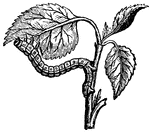
Looper Caterpillar Eating the Leaves of the Apricot (After Reaumur)
"When the caterpillar wants to gnaw the edge of a leaf, it twists its body in such a way that at least…
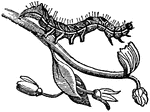
Small Caterpillar of Pimpernel
A specimen of the caterpillar which makes their cocoons of silk with other materials.

Caterpillars of the Small Tortoise-shell Butterfly (Vanessa Urticae) Undergoing Their Metamorphoses
"They select some convenient spot, where they hang themselves up, head downward."
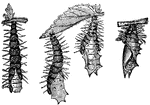
Chrysalides of the Small Tortoise-shell Butterfly Freeing Themselves from the Caterpillar Skin
"To set itself entirely free, the chrysalis alternately lengthens and shortens itself. The old skin…

Emporer Moth Caterpillar
Platysamia cecropia. The caterpillar occurring on a great variety of plants, including many of our fruit-trees…

Fallweb Worm Caterpillar
An illustration of a fallweb worm caterpillar. Fall webworm, Hyphantria cunea, is a moth in the family…

Fallweb Worm Caterpillar
An illustration of a fallweb worm caterpillar. Fall webworm, Hyphantria cunea, is a moth in the family…

Fallweb Worm Caterpillar
An illustration of a fallweb worm caterpillar. Fall webworm, Hyphantria cunea, is a moth in the family…

Front Half of a Caterpillar
Front half of a caterpillar. Labels: a, opening air tubes, a pair of which are shown in black at the…

Hairy Caterpillar
Caterpillars are an insect that is cylinder and is divided by rings into 13 segments. The hairy caterpillar…

Io Moth Caterpillar
An illustration of a Io moth caterpillar. The io moth (Automeris io) is a very colorful North American…

Processionary Caterpillars
"If the guide stops a moment all the followers halt; if he continues the route, they all hasten after…
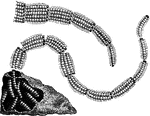
Processionary Caterpillars
"If the guide stops a moment all the followers halt; if he continues the route, they all hasten after…

Willow Leaves Rolled by a Caterpillar
"Besides the rolling and folding caterpillars, there are still those which bind up a good many leaves…
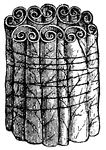
Section of Willow Leaves Rolled by a Caterpillar
"Besides the rolling and folding caterpillars, there are still those which bind up a good many leaves…

Royal Horned Caterpillar
A large caterpillar with long, skinny horns. Usually a beautiful olive and crimson color.
Smooth Caterpillar
The body is cylinder and divided by rings into thirteen segments. The smooth caterpillars don't have…

Spanner Caterpillar
Caterpillars are insects that are cylinder and are divided by rings into 13 segments. The spanner caterpillar…

Tent Caterpillar Cocoon
An illustration of a tent caterpillar cacoon. Tent caterpillars are moderately sized species in the…
Tent Caterpillar Eggs
An illustration of tent caterpillar eggs. Tent caterpillars are moderately sized species in the genus…

White-marked Tussock Caterpillar
Orgyia leucostigma, the White-marked tussock moth, is a moth in the family Lymantriidae. The caterpillar…
Yellow Woolly Bear Caterpillar
An illustration of a yellow woolly bear caterpillar. The Yellow woolly bear caterpillar, Spilosoma virginica,…
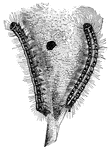
Tent Caterpillars
Tent caterpillars are moderately sized species in the genus Malacosoma in the moth family Lasiocampidae.…
Eight-Spotted Forester Larva
The larva Eight-Spotted Forester (Alypia octomaculata), a caterpillar belonging to the Noctuidae family…
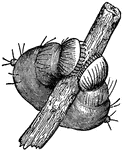
Membranous Legs of a Large Caterpillar Embracing a Twig
Representation of "the two membranous legs of a large caterpillar, of which the hooks of the feet are…
Brown-tail Moth Web
The Brown-tail (Euproctis chrysorrhoea) is a moth of the family Lymantriidae. It is distributed throughout…

Death's Head Moth Caterpillar
"The Death's-head Moth is the European Acherontia Atropos, a hawk-moth with markings on the thorax resembling…










